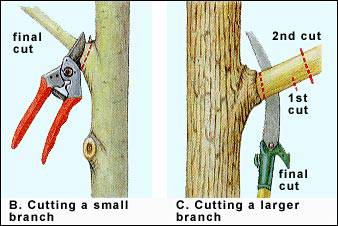Tree Care
The two major categories with tree maintenance are Young Tree Care(PDF, 129KB) and Mature Tree Care(PDF, 618KB). Homeowners can be particularly helpful with young trees by assisting with newly planted trees. This includes weekly watering, mulching the tree basin, and keeping weeds and other plants from interfering with tree root development. The City will handle any necessary young tree pruning.
Older trees need to be monitored for signs of decline or damage. Trees should be pruned as necessary. Emergency pruning is given priority, and requests for safety pruning are evaluated and, if necessary, dealt with. Trees with storm damage, dead branches, blocked sign visibility, pedestrian and vehicle clearances, among other concerns can be reported to City of Albany Public Works.
 Street trees are not pruned or removed for views; to minimize fruit, seed, or leaf drop; to increase sunlight to a landscape or property; based solely on the presence of pests or disease; or for other discretionary purposes. This is an important distinction between the maintenance of street trees and the type of pruning you may prefer to have your arborist perform on your own privately owned trees. In many cases, the above-mentioned pruning may worsen the problem in the long term.
Street trees are not pruned or removed for views; to minimize fruit, seed, or leaf drop; to increase sunlight to a landscape or property; based solely on the presence of pests or disease; or for other discretionary purposes. This is an important distinction between the maintenance of street trees and the type of pruning you may prefer to have your arborist perform on your own privately owned trees. In many cases, the above-mentioned pruning may worsen the problem in the long term.
Trees and Wires
Most wire conflicts are the responsibility of the associated utility. Some wires are considered low-voltage and pruning is usually not required unless there exists excessive strain or abrasion. Service drops that extend from power poles to buildings are an example of this. However, always treat any conductor, downed or otherwise, as high-voltage.
Utility service drops are the responsibility of the property owner. When there is excessive strain on a service drop, property owners may hire a professional tree care service to minimally prune branches away.
Find more information on trees and wires.
Contact PG&E at 800-PGE-5000 or other utility service provider with any questions or concerns.
Tree Roots and Sidewalks
Trees have roots and as trees age these roots enlarge and may cause sidewalk and infrastructure damage. Repair of the sidewalk and some of the infrastructure falls on the adjacent property owner. One way to lessen the chances of tree caused sidewalk damage is to increase the amount of permeable space around the tree. Tree roots need oxygen and moisture from the atmosphere to survive. When they don't get enough they grow out their roots in search of more often pushing out sidewalks in the process.
For more information about sidewalks that have been damaged by tree roots, see our Sidewalks page.